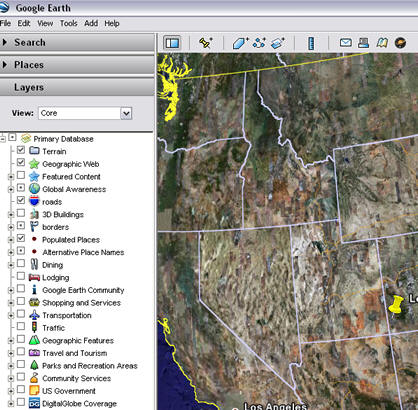September 2007,
Volume 8, Issue 3
 |
|
Google Earth
Google isn't the only site I'm goo-ga
about, but it is among the top. I bought a telescope, my
first, last week. As I prepared to educate myself about the
vast skies surrounding the Four Corners, I found out
that Google has a wonderful downloadable tool for potential
or experienced sky gazers and geographers.
"Google Earth combines the power of
Google Search with satellite imagery, maps, terrain and
3D buildings to put the world's geographic information
at your fingertips.
- Fly to your house. Just type in
an address, press Search, and you’ll zoom right in.
- Search for schools, parks,
restaurants, and hotels. Get driving directions.
- Tilt and rotate the view to see
3D terrain and buildings, or look up to explore the
sky
- Save and share your searches and
favorites."
"Since Google
Earth was launched, users have been exploring our world
and creating content overlays (KML files) to share their
explorations with others. We're now highlighting
user-created KML files each week in the new
Google Earth Gallery. You can also choose to add the
gallery's
Google Gadget to your
iGoogle page."

What about our students? In the last
issue, we talked about the new generation of learners. They
want places to become creative. No more sage on the stage!
Let's give them the space and the tools to express
themselves as they teach themselves. Google Earth allows
students to identify themselves and then to share with
others. Think of students all over the world (ELL?) showing
each other exactly where they live. Think of teaching
them coordinates, a must in order to establish a home site;
entering data about the area; entering images and shapes, directions
and posters; searching the night sky; creating files; on and
on.
Once the globe appeared in Google Earth, I held my cursor
(hand symbol) on the surface and turned the world around and
around. I double-clicked on Kiev, and kept double-clicking
until the city was right there in front of me, buildings,
streets and all. (Be sure to give the image time to focus at
each setting.) In one of the plazas, I took dozens of
photos. Travel time? Seconds. Enjoyment? Maximum. Cost?
Nada. You may also use your mouse scrolling wheel to zoom in
and out of the whole world! What a kick! Have your students
take you to their favorite places or show you their home
towns and schools. Take them to Paris, London, Timbuktu.
Talk about your trip, discuss the foods, the people,
the activities, the geography, the history, the currency,
the politics, the..., the... Limitless possibilities! Have
them enter that mood: creative, competent, and joyful, all
at the same time! As with all tools, Google
Earth and similar tools may not engage everyone, but they
will offer a delightful addition to the international banquet
we can serve our learners. And...it's FREE!
Go to
http://earth.google.com/ to get a tour and to download
the application. Go to
http://earth.google.com/gallery/ to explore some of the
projects people are creating. Your students can be one of
them!
This is tool a step forward from my
previously-mentioned mapping tools. If you liked that one,
you'll love this one! |
CAESAR-II
CDE/AEFL
has
extended the launch date for
CAESAR-II until September
24th. That is good news
because you have an added
opportunity to play in the
sandbox! If you are a
program manager, please,
please get in there and try
all of the new features that
allow you to enter data
easily and intuitively.
Feedback
on features that you would
like to see in the program
is invited, so get your
ideas posted.
At this
time we are NOT soliciting
ideas for reports, as we
have a large backlog on our
wish-list of reports for
data management as well as a
lot of work ahead of us in
replacing the search
function in old CAESAR with
edit reports in CAESAR
II.
To try
CAESAR-II features and to
practice your data entry
skills, go to
https://cdeapps.cde.state.co.us/adulted/.
Enter your old username and
password. If your old
username ends in four
digits, leave those off (
i.e. daveg1234 would be
daveg).
The
system will only be
available for testing until
3pm each day. After 3pm, the
database will be refreshed
by converting data from the
old CAESAR system. The
conversion will take until
midnight. That means that
you can enter any data to
your heart's content, and it
will be erased at the end of
the day.
Debra
Fawcett sent each
program a the list of dates
for Webinar Orientations
being offered. Once you
attend a Webinar
Orientation, you will be
given information to enter
the support site for CAESAR
II users. That site is your
support and communication
area with each other and
with Dave Gustafson and/or
Debra. Always be sure to
read all of the messages
posted since they may answer
many of your questions up
front. Webinars will
continue to be offered at
least once a week, even
beyond the launch date.
ALL PROGRAM MANAGERS ARE
STRONGLY URGED TO SIGN UP
AND ATTEND A WEBINAR
ORIENTATION.
Plan
approximately one hour using
phone and computer
connectivity with Go to
Meeting software. Your only
cost will be the phone call,
which should be minimal,
depending on your own long
distance service. You will
receive instructions on how
to connect once you sign up.
|
W.I.N.E.
Retreat
The First Annual Western Information & Networking
Exchange (W.I.N.E.) was
held at the Two River Convention and Conference Center in Grand
Junction Colorado on
September 13 and 14. The goal of the exchange was to provide an
opportunity for professionals from various state agencies to
come together and learn from each other. (We just happened
to be there during the Palisade Wine Fest and the last week of
the Grand Junction downtown open market..) An additional goal of
the conference was to provide a place for state professionals
with cross-disciplinary interests related to education to meet
and interact with members inside and outside their own
particular disciplines. This year, the conference highlighted Adult
Education, Labor, Corrections and Workforce agencies within the
Western Slope. Thank you, Doug Glynn, for getting adult
education involved!
We exchanged rich ideas and resources throughout the two
days and got to know each other through faces and voices instead
of just titles. All topics discussed deserve mentioning, but I'll share
only two items here.
1. WorkKeys from ACT - So often I hear myself and others
expressing a desire to have alternative ways of showing
employers that students are competent in different areas.
WorkKeys is one answer if the workplace in your area is prepared to
endorse its
certification process. The process of developing WorkKeys is
called profiling. Profiling
involves (a) anaylyzing specific jobs throughout the nation and
in specific states, (b) having workers from different
companies identify each work
task in terms of its demand for "real world" foundational skills
on a scale of 1-6; (c) providing assessments to identify
skill gaps for
specific occupations among potential employees; and (d) providing descriptors to assist in
designing curriculum and training to fill those gaps. For more information
on how to start implementing WorkKeys in your community, go to
http://www.act.org/workkeys/overview/index.html. You may
also contact Thomas Kilijanek, PhD, Senior Consultant for
WorkKeys in Colorado:
thomas.kilijanek@act.org. There are hundreds of careers
already profiled and waiting for your students to meet job
requirements.
2. Dr. Raymond Wlodkowski applies what he "preaches" and had us
working together to experience his message of "Enhancing
Success among Adult Learners." You might remember him from his
talk at Rendezvous. Central to learning, says Wlodkoswski, is the engagement of the learner's emotions
and the linkage between new content and the learner's
knowledge.
Think
of activities that have you feel creative, joyful, and competent
at the same time.
That is the mood, or emotional state, that you want to encourage in
students. Consider also how to help the learner connect with the
material by bringing up prior knowledge related to it. Finally,
as you assessing the amount of learning that students
take from their time with you, consider applying I AM
Competent and H3 checks that follow.
Were these elements present?
- Inclusion: Respect and Correctedness
- Attitude: Relevance and Volition
- Meaning: Challenge and Engagement
- Competence: Effectiveness and Authenticity
How will the 3H's work?
- Head: How will they continue to think about the
content?
- Heart: How engaged were their emotions, and
did they emerge feeling supported?
- Hand: What will they actually do as a result?
Recommended Reading
-
Any of Raymond Wlodkowski and M.B. Ginsberg (his wife and
working partner) publications concerning adult learners and their
motivation, learning diversity, cultural responses,
and related research. Go to
Google and
enter "Raymond Wlodkowski ." Google will open a book
page (new feature) that lists all of an author's
works with links to how to buy it. I've pasted a
couple of entries below.
|
|
by Margery B.
Ginsberg, Raymond J.
Wlodkowski -
Education - 2000 - 336 pages
"Ginsberg and Wlodkowski each
bring a lifetime of knowledge
and experience to this
book.
|
|
|
by Raymond
J. Wlodkowski, Carol
E. Kasworm -
Education - 2003 - 112 pages
This is the 97th volume of New
Directions for Adult and
Continuing Education, a
quarterly report published by
Jossey-Bass.
|
| |
|
|
Atttewell, P., Leavin,
D.E. Domina, T., and Levey, T. Passing the Torch:
Does Higher Education for the Disadvantaged Pay Off
Across the Generations? New York: Russell Sage
Foundation, 2007 - Very interesting research and
worth applying among our students! Click
on the book to go to Barnes and Noble or
do more searching to find other reviews
or costs. |
 |
Zehr , Mary Ann,
Interactivity Seen as Key,
September 12, 2007 -
"Teachers should focus on
seeking out technology that encourages interactive
learning by English-language learners and not be
preoccupied with whether the technology is designed
particularly for such students" - Does that pique your interest? If so, go
to
http://www.edweek.org/dd/articles/2007/09/12/02ell.h01.html
and read the rest. (Thanks, Phyllis Dobson, CCCOnline
for pointing out the article.)
Office 2007
Uh, oh! Here come the new kids on the block with MS
Vista and Office 2007! Be very aware! Most reviews I
have read tell me to wait for Vista if you want to
avoid compulsive hair-pulling. So what do you do if,
like me, you want to upgrade to Office 2007?
Most recommend that you keep Windows XP and install
Office 2007 on that platform. (Whatever you do,
avoid installing Office 2003 on Vista! No, no, no!)
Vista will be fixed soon, we hope, so hold off those
new purchases with Vista platforms. On the other
hand, if your experience has been positive using
Vista, drop me a note with details, and I'll add it
to the next issue.Sooo, what do you do if
your students send you Word documents from Word
2007? You have a few options in addition to the
following two:
- Tell them to resave and send you the file as
a .doc.
-
Go to
http://office.microsoft.com/en-us/products/HA101686761033.aspx
and download a free converter from Microsoft,
which will allow you to open the Word 2007 files
in your Word 2003 application. (Office
2007 has
.docx
or .xlx extensions, which I understand will not open
in Word 2003.)
CCCOnline Courses
Two EDU courses have made and
more to follow if you act quickly!
Puzzle
Enjoy solving the puzzle with
your ABE and ESL students learning math language!
NOTE: As with all images
online, right-click the image of the puzzle below, and
select "copy." Go to Word or another application, and
"paste" the image into a page. You can then resize it and
print it.

From
http://www.edhelper.com
Please send me
your ideas for future issues! What do your students want? |
CONTACT ME:
leecy@coloradoadulted.org
970-562-4418 |